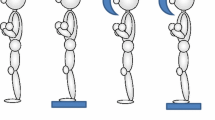Abstract
This study describes a new training system based on an unstable platform and a visual interactive system, that was designed to improve postural control ability. The training system consists of an unstable platform, a safety harness, a monitoring device, and a personal computer. To confirm the effects of the training system, a performance test and a training effect test were conducted. The performance test included calibration and the test-retest experiments. The training effect test was conducted on elderly adults. The results of the calibration demonstrated that the average deviations of COP (center of pressure) in all of the other directions were all less than 0.4cm. The results of the test-retest experiment demonstrated that the ICC (intraclass correlation coefficient) of repeatability was reflective of excellent reliability in both the COP maintenance test and the COP movement test. The training reduced the COP sway path by 5% and the average distance of the COP sway by 32.4%. The RMS (root mean square) of COP after training was reduced by 24% and 33% in the ML (medio-lateral) and AP (anterior-posterior) directions. The training also caused a 25% reduction in the results of the Timed Up and Go test. The PTBW (peak torque/body weight) value was increased by 31% and 17.5% in the knee and ankle joints. The experimental results suggest that this postural control training system using an unstable platform could be applied to training to improve postural control ability in elderly adults.
Similar content being viewed by others
References
F. B. Horak, C. L. Shupert and A. Mirka, Components of postural dyscontrol in the elderly: a review, Neurobiol. Aging 10(10) (1989) 727–738.
U. Rosenhall, Degenerative patterns in the aging human vestibular neuro-epithelia, Acta Otolaryngol. 76 (1973) 208–220.
B. Bergstrom, Morphology of the vestibular nerve. 3. Analysis of the calibers of the myelinated vestibular nerve fibers in man at various ages, Acta Otolaryngol. 76 (1973) 331–338.
U. Rosenhall and W. Rubin, Degenerative changes in the human vestibular sensory epithelia, Acta Otolaryngol. 79 (1975) 67–80.
C. A. Laughton, M. Slavin, K. Katdare, L. Nolan, J. F. Bean, D. C. Kerrigan, E. Philips, L. A. Lipsite and J. J. Collins, Aging, muscle activity and balance control: physiologic changes associated with balance impairment, Gait Posture 18(2) (2003) 101–108.
S. R. Lord, J. A. Ward, P. Williams and K. J. Anstey, Physiological factors associated with falls in order community-dwelling women, J. Am. Geriatr. Soc. 42(1) (1994) 1110–1117.
R. H. Whipple, L. I. Wolfson and P. M. Amerman, The relationship of knee and ankle weakness to falls in nursing home residents, J. Am. Geriatr. Soc. 35(1) (1987) 329–332.
D. M. Buchner, M. E. Cress, B. J. Lateur, P. C. Esselman, A. J. Margherita and R. Price, The effect of strength and endurance training on gait, balance, fall risk, and health services use in community-living older adults, J. Gerontol. Biol. Sci. Med. Sci. 52(4) (1997) M218–224.
M. E. Cress, D. M. Buchner, K. A. Questad, P. C. Esselman, B. J. Lateur and R. S. Schwartz, Exercise: effects on physical functional performance in independent older adults, J. Gerontol. Biol. Sci. Med. Sci. 54(5) (1999) M242–248.
R. G. Hamman, I. Mekjavic, A. I. Mallinson and N. S. Longride, Training effects during repeated therapy sessions of balance training using visual feedback, Arch. Phys. Med. Rehabil. 73(8) (1992) 738–744.
J. A. Hess and M. Woollacott, Effect of high-intensity strength-training on functional measures of balance ability in balance-impaired older adults, J. Manip. Physiol. Ther. 28(8) (2005) 582–590.
S. Morioka and F. Yagi, Influence of perceptual learning on standing posture balance: repeated training for hardness discrimination of foot sole, Gait Posture 20(1) (2004) 36–40.
R. D. Seidler and P. E. Martin, The effects of short term balance training on the postural control of older adults. Gait Posture 6(3) (1997) 224–236.
U. Granacher, A. Gollhofer and D. Strass, Training induced adaptations in characteristics of postural reflexes in elderly men, Gait Posture 24(4) (2006) 459–466.
P. Page, Sensorimotor training: A “global” approach for balance training, J. Bodywork Movement Ther. 10(1) (2006) 77–84.
D. Podsiadlo and S. Richardson, The timed Up & Go: a test of basic functional mobility for balance-impaired elderly persons, J. Am. Geriatr. Soc. 39 (1991) 142–148.
J. J. Bartko, Measures of agreement: a single procedure, Stat. Med. 13 (1994) 737–745.
A. Shumway-Cook, S. Brauer and M. H. Woollacott, Predicting the probability for falls in community dwelling older adults using the up and go test, Phys. Ther. 80(9) (2000) 896–903.
J. J. Jeka and J. R. Lackner, The role of haptic cues from rough and slippery surfaces in human postural control, Exp. Brain Res. 103(2) (1995) 267–276.
S. Clapp and A. M. Wing, Light touch contribution to balance in normal bipedal stance, Exp. Brain Res. 125(4) (1999) 521–524.
J. R. Lackner, E. Rabin and P. Dizio, Stabilization of posture by precision touch of the index finger with rigid and flexible filaments, Exp. Brain Res. 139(4) (2001) 454–464.
Author information
Authors and Affiliations
Corresponding author
Additional information
This paper was recommended for publication in revised form by Associate Editor Eung-Soo Shin
Yong-Jun Piao received the M.S. degree in Biomedical Engineering from Chonbuk National University in 2005. His research interests include Postural control, Sensory integration Rehabilitation engineering.
Tae-Kyu Kwon received the Ph.D. degree from Tohoku University in 1999. His research interests include Rehabilitation engineering, Bio-mechatronics.
Dong-Wook Kim received the Ph.D. degree in Biomedical Engineering from Hokkaido University in 1995. His research interests include Silver engineering, Sensory information engineering.
Nam-Gyun Kim received the Ph.D. degree from University of Strasbourg in 1987. His research interests include Postural control, Rehabilitation engineering.
Rights and permissions
About this article
Cite this article
Piao, YJ., Kwon, TK., Kim, DW. et al. Development of a new training system for improving the postural control ability of elderly adults. J Mech Sci Technol 23, 324–334 (2009). https://doi.org/10.1007/s12206-009-0109-x
Received:
Revised:
Accepted:
Published:
Issue Date:
DOI: https://doi.org/10.1007/s12206-009-0109-x




